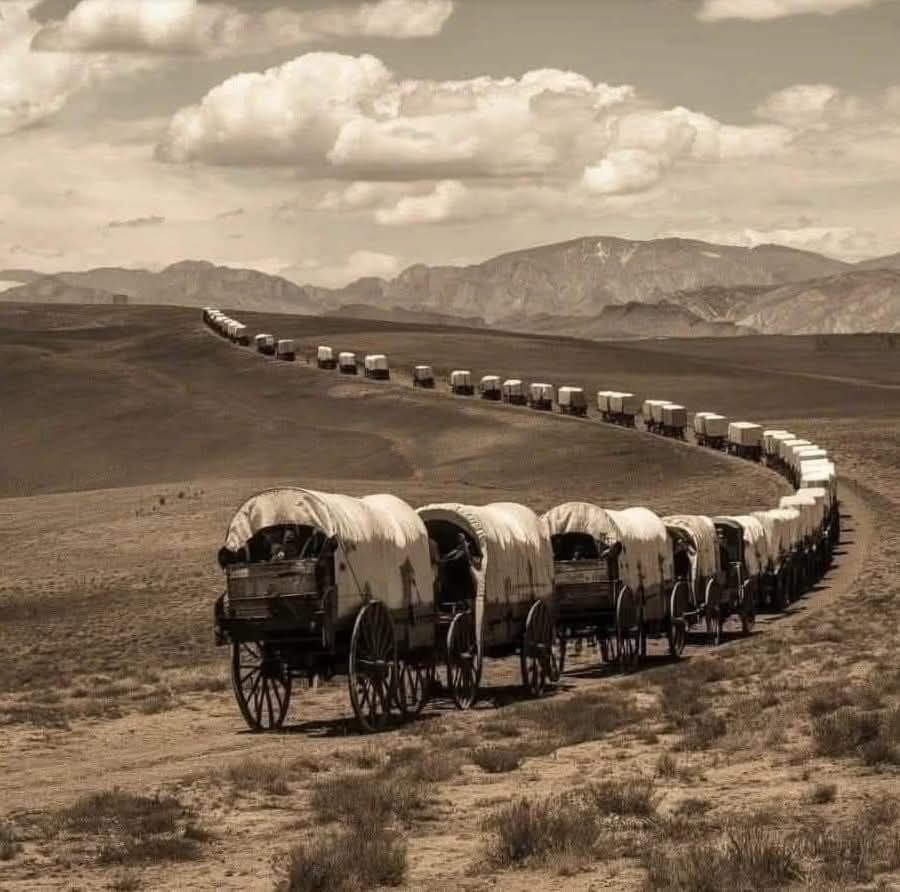In the 1860s, the lure of a new life and the promise of the West pulled Americans ever further into the unknown. One of the great arteries of this westward movement was the route known as the California Trail—a network of trails and tracks that connected the Missouri River region, crossed the Great Plains, skirted the Rocky Mountains, traversed the vast empty lands of what would become Nevada, and climbed the Sierra Nevada into California.
On one scorching summer morning, a sizeable wagon train assembled at a dusty river crossing, oxen lowing, wagons laden with chests and crates, provisions, tools, livestock and a clutch of trembling children and anxious adults. Their destination: the rich valleys of California. Their journey: a gamble against drought, rattlesnakes, desert waste, broken wagons and the inexplicable hunger of hope.
Setting out into the great unknown
These emigrants left behind known lives. They said goodbye to farms, small towns, family ties and settled rhythms. With them they carried dreams of gold, fresh land, open skies and the possibility of reinvention. Each wagon space was precious—not only in weight but in meaning. A skillet, a baby’s toy, a kerosene lamp, a Bible, journals to record the trek.

As the train rolled west, the terrain changed slowly but inexorably. The open plains gave way to sagebrush flats, the skies wider, the air dryer, the threat of water more ominous. The daily routine became survival: breaking camp early, watering the animals while still cool, loading the wagons, navigating washes and ridges, scanning the horizon for the next source of water or shelter. At night they huddled around campfires, listening to adult fears disguised as jokes, and letting the children drift off under unfamiliar stars.
Nevada’s cruel gift—beauty and brutality
When the wagons entered what today is Nevada, the terrain shifted again. Here the challenge was not only distance but desolation. The stretches between reliable watering holes lengthened. The ground cracked. The winds kicked up fine dust that coated clothes, faces and wagons. The Humboldt River, in its winding path, became both friend and deception: sometimes shallow, unreliable; other times a blessing for weary animals and parched throats.
Some migrants referred to a section as “the 40-mile wilderness” between known water sources, a stretch so barren that day after day seemed the same—brown scrub, distant ridges bathed in heat shimmer, and the slow hum of despair settling into some. For those whose oxen grew lame, whose supplies dwindled, or whose faith in companionship faltered, the desert became a mirror of their doubts.
Yet amid the hardship there remained moments of triumph: a cool spring discovered just as camp was being broken; children laughing as they splashed in shallow pools; a wagon master leading the oxen over a ridge and exclaiming that they had gained footing on firmer ground again. The contrast of hope and hazard, of vision and exhaustion, shaped each day.
The human cost—fatigue, illness and doubt
The journey was not simply a contest with geography but with the human body and psyche. Oxen could collapse from heat. Wagons could break their axles on hidden rocks. Children could fall ill with fever, dysentery or exhaustion. Adults might grumble, cry, pray, curse the planner who’d assured them this route was manageable.
The desert tested morale. The endless sameness of sage and scrub, the distant mountains standing aloof, the nights cold and star-brilliant—yet so vast and indifferent—wore on the mind. Some families paused to rest, hoping the animals would recover. Others pressed on, unwilling to delay until supplies ran out. The wagon train was a community, bound by common challenge, but also by individual dread.
Reaching the Sierra Nevada—and whatever lies beyond
After passing through Nevada’s emptiness and crossing the Humboldt River system, the wagon train approached the Sierra Nevada mountains—the final great barrier before California. The climb was steep, the passes narrow, the snow-free window limited. Some travelers feared the high ridges as much as the desert plains.
Yet as the wagons struggled upward, the pay-off was visible: fir trees became more frequent, streams clearer, wildflowers edging the path. The first glimpses of the Sacramento Valley stirred new energy. Families whispered that the end of hardship might be near, that new beginnings awaited.
And when the wagons finally emerged into valley land, with green fields and water flowing, tired but triumphant, the sense of arrival mixed with fatigue, with cost accounted, with new uncertainties. What would this new land demand from them? Could they turn this gamble into a home? Could they plant, harvest, build a community? The journey had been brutal. The destination promised much.
Legacy of the trail and its travelers
The story of this wagon train—and many like it—is more than a tale of movement. It is a story of hope meeting hardship, of individuals striving against nature, of families bound together under immense stress, and of a continent being transformed one set of wagons at a time.
The tracks left behind, the worn trails across Nevada, the scattered grave markers, the journals and letters—these all echo the sacrifices and ambitions of the emigrants. That vast empty desert between the Missouri and the Pacific was not simply something to cross—it was a trial by which lives were tested and identities remade.
When we reflect on that wagon train in the 1860s, we recognize something essential: these people weren’t just seeking land or gold—they were seeking possibility. They carried more than supplies—they carried dreams, fear, love, determination, and the conviction that a new horizon might redeem what had been left behind.
And those who drove the wagons west were not just travelers—they were pioneers, forging a route across terrain that would shape generations to come.